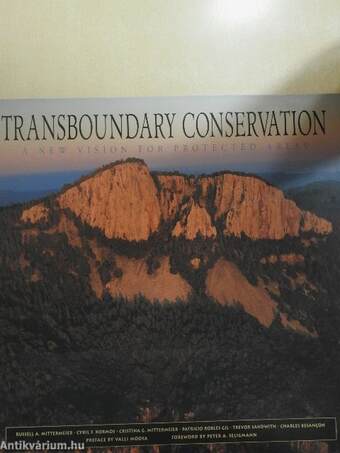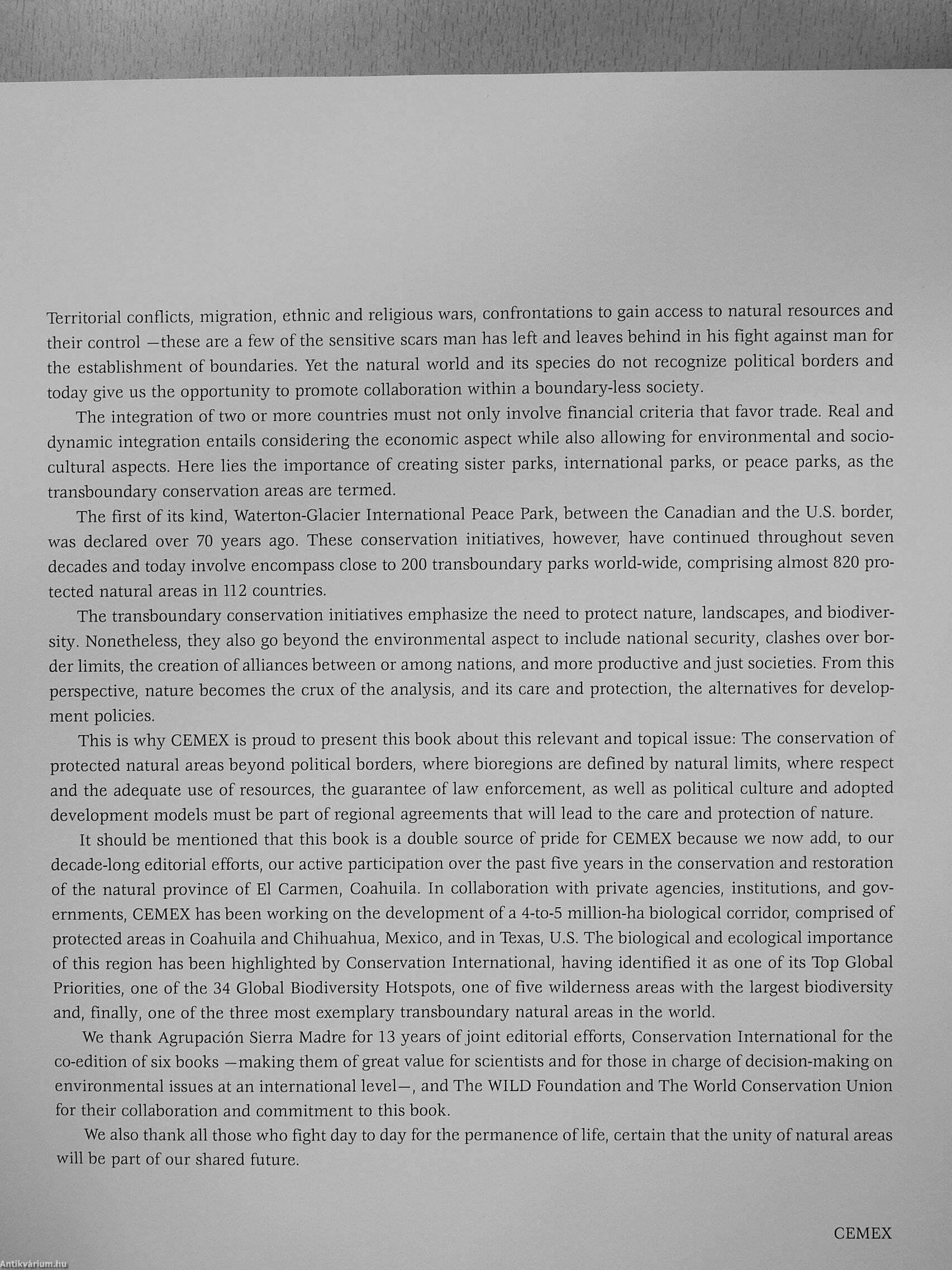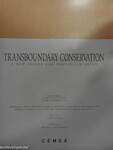1.116.081
kiadvánnyal nyújtjuk Magyarország legnagyobb antikvár könyv-kínálatát
Transboundary Conservation
A New Vision for Protected Areas
| Kiadó: | Cemex |
|---|---|
| Kiadás helye: | |
| Kiadás éve: | |
| Kötés típusa: | Vászon |
| Oldalszám: | 369 oldal |
| Sorozatcím: | |
| Kötetszám: | |
| Nyelv: | Angol |
| Méret: | 29 cm x 31 cm |
| ISBN: | 968-6397-83-3 |
| Megjegyzés: | Színes fotókkal gazdagon illusztrálva. |
naponta értesítjük a beérkező friss
kiadványokról
naponta értesítjük a beérkező friss
kiadványokról
Előszó
TovábbFülszöveg
TYanshoundary Conservation: A New Vision for Protected Areas reflects the strong commitment of CEMEX, Conservation International, and Agrupación Sierra Madre to publishing the latest information on global biodiversity conservation. This book highlights the new approach of transboundary conservation -one that promises to have a profound impact on protected area planning and biodiversity protection, and the potential to influence social and political change around the world.
A transboundary conservation area refers to an area that straddles international boundaries and is managed cooperatively for conservation purposes. These may include adjacent national parks and other protected areas, as is the case with the oldest and perhaps most famous example: The Waterton-GIacier International Peace Park between the United States and Canada, established in 1932. Although the concept is not new, the growth in internationally adjacent protected areas in recent years has been very rapid. In... Tovább
Fülszöveg
TYanshoundary Conservation: A New Vision for Protected Areas reflects the strong commitment of CEMEX, Conservation International, and Agrupación Sierra Madre to publishing the latest information on global biodiversity conservation. This book highlights the new approach of transboundary conservation -one that promises to have a profound impact on protected area planning and biodiversity protection, and the potential to influence social and political change around the world.
A transboundary conservation area refers to an area that straddles international boundaries and is managed cooperatively for conservation purposes. These may include adjacent national parks and other protected areas, as is the case with the oldest and perhaps most famous example: The Waterton-GIacier International Peace Park between the United States and Canada, established in 1932. Although the concept is not new, the growth in internationally adjacent protected areas in recent years has been very rapid. In 1988, there were 59 such complexes around the world. This most recent analysis Indicates that there are 188 complexes involving 818 protected areas in 112 countries, representing approximately 17% of the global extent of protected areas.
This approach has generated considerable attention and enthusiasm in the last few years because quite often conservation priorities span two or more countries, thereby making international collaboration a necessity. Establishing adjacent protected areas also results in larger areas under protection, and international collaboration can generate more efficient protection, allowing for better use of scarce conservation resources. Transboundary conservation is also consistent with corridor planning —linking protected areas in broader landscapes to increase their long term ecological and evolutionary potential.
In addition, transboundary conservation can have a wide range of social and political benefits, including reuniting communities divided by arbitrary borders, facilitating the movements of mobile indigenous peoples, helping broker peace and reconciliation between countries with a history of corrflict, and generating substantial economic benefits. In essence, they can facilitate a more integrated and coherent approach to management of a landscape across borders, in biological, socioeconomic, and political terms, offering hope that conservation can transcend politics and help resolve long-standing and often complex problems.
This book reviews the history of the transboundary conservation concept and application, as well as summarizes the latest information available and the many benefits that these areas provide. The book focuses on 28 transboundary conservation areas, spanning all continents including Antarctica and several marine transboundary conservation areas. While recognizing that transboundary conservation can in some instances be difficult to achieve, and can even complicate conservation efforts by adding a layer of international complexity to the equation, it is nonetheless a very exciting development. It is our hope that a more thorough understanding of transboundary conservation will allow practitioners to harness this mechanism more effectively.
An additional highlight of this book is the inclusion of the International League of Conservation Photographers (ILCP) to the long and productive relationship between CEMEX, Conservation International, and Agrupación Sierra Madre. The imperative to use the best of nature photography to illustrate cutting edge conservation science served to catalyze the creation of this group and its mission, which is to bring forth the power of photography to help propel the conservation agenda. We want to recognize the contribution of the many photographers whose work has been featured in this conservation series throughout the years. Vissza
Témakörök
- Természettudomány > Növényvilág > Nemzeti parkok, arborétumok
- Idegennyelv > Idegennyelvű könyvek > Angol > Művészetek > Fotóművészet
- Idegennyelv > Idegennyelvű könyvek > Angol > Természettudományok > Egyéb
- Természettudomány > Növényvilág > Természetvédelem
- Művészetek > Fotóművészet > Albumok > Tematikus
- Művészetek > Fotóművészet > Idegen nyelv > Angol
- Művészetek > Fotóművészet > Témái > Természet

















